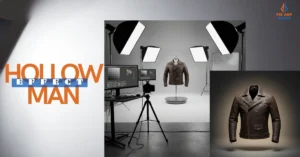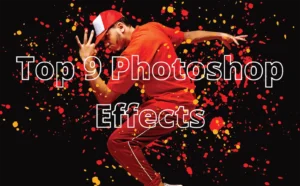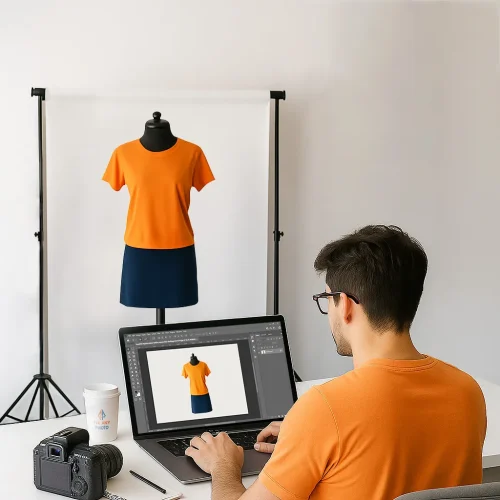Hey, there! Our manual on image manipulation by the magic of photo so to speak. Click counter its title reads, but this translator sucks and you know it wasn’t really smoking_title in the original Well, if you are a new photographer who cannot stop using social media or like to play with photos; then you have landed at the right place. A wonderful exercise for photographers, graphic designers, and anyone seeking to stretch the limits of their creativity. But it is not merely about window dressing. It shares stories, storms emotions, and takes the viewers to another field. This is a powerful scoring, and it has the power enough to make every normal picture look magical.
Understanding Photo Manipulation

Photo manipulation service is an activity of editing photographs, whether it be through digital or analog means in order to enhance them. For example, think about one image of a sunset that you have taken. In a very elementary photo editing sense, you may also increase the brightness and contrast so that the colors pop just slightly more. A photo manipulation service on the other hand may include adding a lot of birds into the sky, toning down or increasing your sets from the sunset into something more surreal as well as blending all of them with the skyline right now upon another scenario.
Popular Photo Manipulation Software
Especially when you are in the line of profession that deals with photo manipulation. Having a correct software matters most of time. Here are some of the most popular tools and their relative strengths and weaknesses.
Adobe Photoshop
The gold standard for making modifications to your photos is Adobe Photoshop. Big options and big features mean that professionals love it.
Positive aspects:
Powerful Tools: There are tools for simple as well as sophisticated manipulations. That includes layers, masks, brushes, and filters.
Versatility: Versatility Graphic design, digital painting, and 3D design all work well with Photoshop.
Extensive Resources: Photoshop does come with hundreds of tutorials and events surrounding it to help you take your first steps into learning the program.
Regular Updates: as always Adobe does regular updates with its own added features & performance better.
Negative aspects:
Cost: Photoshop is subscription-based, which can be expensive for some users.
Complexity: The learning curve is difficult, particularly for beginners. A huge number of tools and options might be difficult.
System Requirements: It needs a good enough, decent-performance PC to work on.
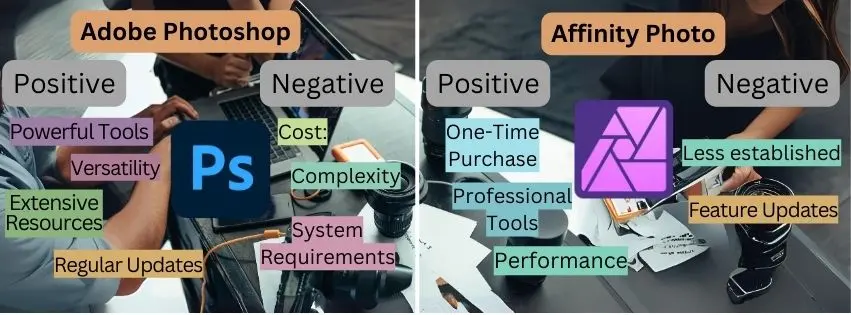
Affinity Photo
Affinity Photo is a well-known newer option that has grown in popularity for its professional-level offerings combined with no subscription model.
Positive aspects:
One-Time Purchase:
Another great feature of Affinity Photo is that, unlike Photoshop, it does not adopt a payment method via subscriptions making the cost more sustainable in the long run.
Professional Tools:
It has numerous professional tools and even capabilities comparable to Photoshop, such as RAW processing support, HDR, or panoramic stitching.
Performance:
Affinity Photo is well-regarded for its performance and how it doesn’t hog system resources.
Negative aspects:
Not as Mature: It is a newer program, so there will be fewer tutorials and community resources available compared to Photoshop. It is also a good tool, but its compatibility with Adobe formats of files is more limited.
Feature Updates: Although it receives updates, the frequency and number of new features could be different from those provided by Adobe.
Step-by-Step Photo Manipulation Tutorial
Layering
Create Your Image With Layers.
Layers are added to one on top of the other which will help you in loading an image separately for any portion. They allow you to break out parts to edit without affecting the rest of the image.
To start:
- Open the photo with your editing software.
- Make a new layer for each big change you want to make (one for color adjustments and one for new elements)
- This allows you to easily edit and undo changes without affecting your whole image.
Techniques for Blending Elements
The goal of blending effortlessly parts is to create a sense of natural blending. Here’s how.
- To remove harsh lines, use the Eraser tool’s soft edge.
- Adjust the opacity of your layers to smooth out the transitions.
- Layer masks let you to hide or show areas of layers without permanently removing them.
- Experiment with different blending modes (such as Multiply, Screen, or Overlay) to see how they affect the look of your layers.
Color Correction and Enhancement
Adjusting colors, contrast, and brightness
Sometimes your shot need a little editing to make the colors shine or to correct lighting difficulties.
Try the following steps:
- Use the Adjustment tools (Brightness/Contrast, Levels, and Curves) to fine-tune the overall appearance.
- Use the Hue/Saturation tool to increase or modify specific colors.
- If your image has a color cast (such as a bluish tinge), use the Color Balance tool to adjust it.
Using Filters and Effects to Enhance the Image
Use filters (such as Sharpen or Blur) to attract attention to important elements of the image.
- To add a creative touch, use effects such as vignette or lens flare.
- Be careful not to overdo it—subtlety is often required to keep your shot looking professional.
Adding and Removing Elements
Cloning and Healing Tools for Element Removal.
Sometimes you need to remove unwanted items from your shot. The Clone Stamp and Healing Brush tools are your most valuable partners in this situation:
- Use the Clone Stamp tool to duplicate a clean area of the image and paint over the unwanted element.
- The Healing Brush tool blends the area you paint into the surrounding pixels, making the removal less apparent.
Techniques for Adding New Elements or Backgrounds
Adding new elements or changing the background can completely transform your photo. Here’s how:
- Use the Selection tools (such as the Lasso or Magic Wand) to remove the piece you want to add.
- Place it on your photo and use the Move tool to position it.
- Use the techniques discussed above to match the lighting and color of the new piece to the rest of the image.
- When creating new scenery, be sure to scale and position the background layer appropriately, and use layer masks to smoothly merge your main topic.
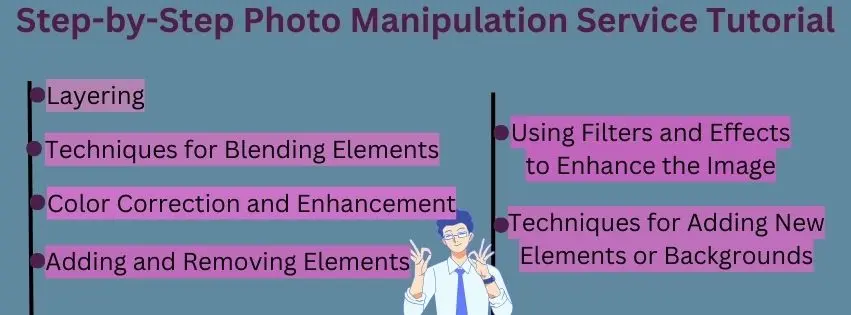
Conclusion
Thank you for following us during the photo manipulation tutorial! Because today you should have a pretty good idea of what it is, how to do the three levels of edits, and the tools used depending on the type.
There is something for everyone perfect if you are new to picture editing or professionals looking at how can make better your skills. Practice, and experiment with your photos to get the hang of photo alteration. There is absolutely no reason to be hesitant about trying new techniques with other forms of software and testing out your creativity as far as it can go.



